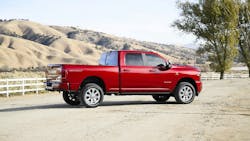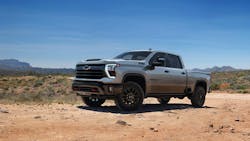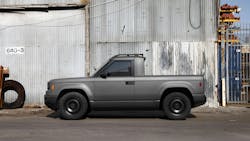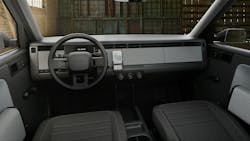Trump kicked off his trade war by imposing 25% tariffs on Canada and Mexico and other countries, especially China. But he paused and modified them several times, which caused confusion among builders. Tariffs since have been lowered or remain duty-free on certain automotive products compliant with the United States-Mexico-Canada Agreement (USMCA). But aluminum and steel tariffs were recently hiked to 50%, which could affect some automotive parts.
In his first term, Trump directed renegotiation of the North American Free Trade Agreement (NAFTA) with terms more favorable to the U.S. and addressing additional issues. It took effect in 2020. Like NAFTA, the USMCA covers automotive production in the three countries at varying tariff levels.
The domestic Big Three automotive firms, with numerous manufacturing activities inside American borders, also have plants north and south of the border, and formed plans to move some Canadian and Mexican assembly back into the States to sidestep tariffs. General Motors is reportedly shifting some production of light-duty pickups from Oshawa, Ontario, to Fort Wayne, Indiana. GM, which also builds pickups in Mexico, is adding 250 workers at Fort Wayne to support production increase, according to news reports. About 750 Canadian workers will be affected as the Oshawa plant drops from three shifts to two. Chevrolet Silverado Heavy Duty pickups are built at GM’s factory in Flint, Michigan, which was modernized in recent years. GMC Sierra light- and heavy-duty pickups are built in Silao, Mexico, and it’s not clear if that will change.
Ford Super Duty trucks are assembled at the Kentucky Truck Plant in Louisville and the Ohio Assembly Plant in Avon Lake. Both are operating at capacity. Last year, Ford announced that Super Duties would also be produced beginning in 2026 at its Oakville, Ontario, assembly complex. That plant was being retooled to accommodate the new production, but that might or might not happen as planned, though some production could serve the Canadian market that might otherwise face retaliatory 25% tariffs on American-assembled pickups. Ford F-150 pickup trucks are produced primarily at two assembly plants in Dearborn, Michigan, and Claycomo, Missouri. Sixteen plants supply components and parts to support F-150 assembly, according to online reports.
Stellantis, whose Ram Brand Heavy Duty pickups have been built in its large Satillo, Mexico, plant, could conceivably move some production to Detroit-area factories that have new capacity. A plan for this dates back to 2018 but was not carried out as the Satillo plant was since expanded. The company has ceased production of the Classic Ram 1500 in Warren, Michigan, so that plant could take over some assembly of 2500 and 3500 HD models. “That looks like speculation,” was a Ram spokesman’s sole reaction to this report.
How is the demand for pickup trucks?
Meanwhile, on the sales side, incentives have crept back into the retail market as inventories of new pickups have risen, more than satiating a shortage caused by high demand. But demand is softening, and lines of shiny new pickups continue to populate dealers’ lots across the U.S., and manufacturers and dealers are now under pressure to move them out.
“Employee pricing” from Ford and Stellantis was available across all auto and truck lines in the Spring and into the Summer, and some 0% interest deals are being advertised. For anyone needing a pickup truck or any other new vehicle, it’s a good time to buy, especially if it beats the pricing effects of tariffs.
In the perennial battle for market share among the domestic Big Three pickups makers, General Motors was ahead in this year’s first quarter with 40%, Ford second at 35%, and Ram third at 17%, according to market reports. Sales by Toyota and Nissan comprised the remainder. GM’s share includes combined Chevrolet Silverado and GMC Sierra sales, up 2.3% over last year. Ford’s F-series remains the top selling product line overall, but sales were down 10.2% in this year’s first quarter. The Ram pickup sales slump was countered by its commercial van sales, which were up by about 16%, according to the company.
Product-wise, all of the Big Three continue to use body designs introduced two to three years ago, though with continuous technical and computer-centered upgrades to enhance safety and efficiency. These include expanded driver-assist and trailer-towing features, and software enhancements to aid dispatching and tool and material inventories. Large gasoline and diesel engines head powertrains in heavy pickups, and light-duty trucks can be had with gasoline, gasoline-electric hybrid, and battery-electric propulsion.
Alternative energy options in pickup trucks
Demand for hybrids has picked up as customers realize they have no limits on range, unlike electric vehicles, which can work fine in local driving but face questionable charging availability on long trips. Among full-size pickups, Ford’s F-150 PowerBoost hybrid and Ram’s 1500 eTorque mild hybrid are the two current products, while Chevrolet is rumored to be readying a Silverado hybrid for 2027. In compact trucks, Ford’s Maverick hybrid has gained strong popularity, and Toyota now offers a hybrid version of its Tacoma, which is now a mid-size model.
Although early adopters and environmentally conscious souls continue to buy electric vehicles, demand for costly EVs in general began dropping about two years ago as mainstream customers balked at the entire idea. Builders have cut back on EV production, reducing activity and idling some production lines.
Federal government backing via hefty tax credits is threatened due to Trump Administration hostility, further eroding buyer desire for them. Yet advances in battery chemistry have made EVs more technically and financially feasible, and discovery of lithium deposits in the United States and elsewhere promise plentiful supplies at lower costs for lithium-based batteries.
Even with lower sales recently, Ford’s F-150 Lightning has become the best-selling electric pickup, recently moving ahead of the radically styled Tesla Cybertruck. Helping Ford is its long history in the automotive business and perhaps the fact that the Lightning looks like a “real” pickup.
Although Tesla’s car sales remain strong, its market share is dropping as other makers establish themselves in the EV arena. For a time, Tesla CEO Elon Musk’s political activities turned the Cybertruck into a target for some anti-Trump vandals who committed highly publicized acts of fiery destruction. But the Cybertruck has its fans: In on-line posts, some are boosting its ability to do real work.
Chevrolet continues to promote its Silverado EV for work or personal use, and expansion of the line from its initial Work Truck trim to the consumer-focused, fancier RST version, which recently went into production. A delayed starter, meanwhile, is Ram’s Ramcharger EV pickup, whose production has been pushed back until later this year or beyond as the Stellantis division concentrates on its conventionally powered pickups. Rivian’s R1T pickup gets good reviews from auto writers for its performance and general truckability.
And an entirely new compact electric truck is coming from an entirely new company: Slate Auto. The Detroit-area start-up, staffed by industry veterans, is planning to field a new regular-cab pickup and, with an add-on rear cap, a five-seat SUV. It has an exceedingly simple overall design, using single-color plastic body panels, a no-frills interior with basic gauges and controls, and no computer screen or other electronic features. Aided by the federal $7,500 tax credit, a Slate EV pickup will reportedly start at less than $20,000; but if the incentive disappears, Slate’s financial sense will diminish. We will see.










